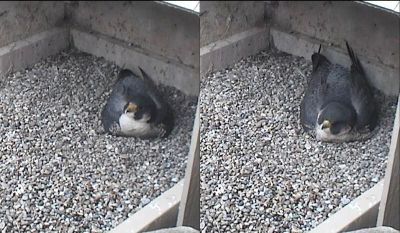 When I describe the activities of the Pitt peregrines people often ask me, “How do you tell them apart? Which one is Dorothy? Which is E2 (the male)?”
When I describe the activities of the Pitt peregrines people often ask me, “How do you tell them apart? Which one is Dorothy? Which is E2 (the male)?”
Unlike many songbirds male and female peregrine falcons look alike. The main difference between the sexes is their size – the female is up to 30% larger than the male – but this is only useful when you see them side by side. Even then they can fool you if the male has puffed out his feathers and the female has not.
So how to tell?
Thanks to the webcam at the University of Pittsburgh nest we’re able to take a closer look and – this may sound incredible – Dorothy’s and E2’s faces are different. When you know what to look for they’re recognizable just the way humans are.
To show you what I mean I captured some screenshots of both birds in similar poses and placed them side by side. In the composite above E2 is on the left, Dorothy is on the right. (There is another composite photo too, if you click on this one.)
First, the easiest sign: Look at their foreheads. E2 has a line of white feathers where his beak meets his forehead. Dorothy’s forehead is all gray. Last year I remarked that the yellow on E2’s beak looked “longer” but it’s his white forehead that causes that illusion. (Thanks to Nora on the Cleveland Falcon Forums for putting a name to this feature.)
Expanding the comparison: Look at their heads. E2’s looks more square or angular, partly because of his white forehead, and his eyes aren’t in shadow. Dorothy’s head is rounder on top, her eyes are more deeply set and her eyebrow line is sharper. My friend Karen says this makes Dorothy’s eyes look fierce.
Finally, it’s clear in the composite photos that E2 is smaller than Dorothy. When he sits in this position his tail lies flat on the gravel while Dorothy’s body is so long that her tail hits the back wall of the nest box and she bends it to the side.
Armed with these clues you’ll have many chances to observe Dorothy and E2 as they incubate their eggs in the coming weeks. See if you can tell the difference.
Keep in mind the facial differences apply only to these individual birds, not to all peregrines, and that you would never see this without a webcam. When peregrines fly or perch the only way to tell the sexes apart is by their size.
(photos from National Aviary webcam at University of Pittsburgh)
Thanks for this info. I have been tracking the Peragrines in Worcester and can’t tell them apart. All I know is that I have not seen them together since last Thursday so I am hoping she has laid her eggs so we will have more.
Great webcam captures. It is going to be so fun to watch once she has them.
THANKS FOR SUCH A RICH AND EDUCATIONAL BLOG ON DOROTHY AND E2’S INDIVIDUAL IDENTITY. With your help, we are “easily” now able to see the difference between these two birds. You’re the best, Kate.
OH!! That explains it! I thought only Dorothy sat on the eggs and I was just going to write and ask when she eats!! I didn’t realize both of them sat the eggs!! How cool is that!! So they BOTH do the ‘big sit’!!
THANKS!! for all you do!!
Yes, this is exciting. My third egg-watch since my cousin Libby Strizzi cued me into this special bird. I am not as avid as she and you but have learned from tuning in, and feel just a bit more attached to this world.
OK. Now that I think I can tell which is which, is it unusual that E2 has been sitting on the eggs for at least a few hours. I thought Dorothy did most of the sitting. Of course I could be wrong about who is in the nest.
Oh, never mind. She is back.
Dorothy incubates all night (a species trait) and for a lot of the day. E2 gives her longer daytime breaks than males at some other nest sites. I believe this division of labor is a trait of this couple and that daytime incubation duty varies from couple to couple.
We walked to 5th and Neville Sts. on Thurs. to pay respects to the three Pittsburgh police officers killed in line of duty the previous Sat. For those readers not in town, the cortege passed that point on the way to their combined memorial service.
It was remarkable. Young, old, all races, many priests from nearby St. Paul’s Cathedral, students, older people, all in total silence.
The reason I am posting this here is that just before the procession passed a falcon swooped over and around our area. I am surely anthropomorphizing, but it was very comforting to see the bird sympathizing. I assure you–there were no pigeons nearby!